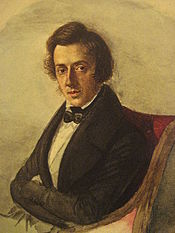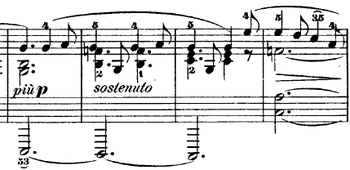- Nocturnes, Op. 37 (Chopin)
-
The Nocturnes, Op. 37 are a set of two nocturnes written and published by Frédéric Chopin in 1840,[1] though it is thought that the Nocturne in G major, Op. 37, No. 2 was composed in 1839 around the time of his stay with author George Sand in Majorca.[2][3] Unusually, neither piece carries a dedication.
This set of nocturnes was originally considered to be one of the better sets, yet its popularity slowly decreased in the twentieth century.[2] Blair Johnson maintains, however, that the pieces are still "wonderful specimens, being something of a hybrid between the more dramatic Opus 27 and the far simpler textures and moods of Opus 32."[2] Robert Schumann commented that they were "of that nobler kind under which poetic ideality gleams more transparently."[2] Schumann also said that the "two nocturnes differ from his earlier ones chiefly through greater simplicity of decoration and more quiet grace."[4]
Gustav Barth commented that Chopin's nocturnes are definite signs of "progress" in comparison to John Field's original nocturnes, though the improvements are "for the most part only in technique."[5] However, David Dubal feels that the pieces are "more aptly described as ballades in miniature."[6]
Contents
Nocturne in G minor, Op. 37, No. 1
The Nocturne in G minor is initially marked as andante sostenuto and is in 4/4 meter. In measure 41, the key changes to E-flat major and returns to G minor in measure 67. The piece is a total of 91 measures long, ending with a Picardy third, and is in ternary form.[2] One of Chopin's students once claimed that Chopin himself forgot to mark the increase in tempo for the chorale, which led to the section being played too slowly.[7]
James Friskin commented that the nocturne is "one of the simpler nocturnes" and is similar to the Nocturne in G minor, Op. 15, No. 3 in that it "has similar legato chord passages in the contrasting section" though this nocturne "has a more ornamental melodic line".[8] Dubal also agreed that the nocturne is "of lesser importance."[9] Critics, however, have often pointed to the potential allusion to religion in the middle section. Maurycy Karasowski commented that the middle section has "a church-like atmosphere in chords."[10] Johnson also thought the chords to be "chorale-like" and commented that "some biographers have felt that this music represented Chopin's faith in the consoling power of religion."[2]
Nocturne in G major, Op. 37, No. 2
The Nocturne in G major is initially marked as andantino and is in 6/8 meter, remaining so for all 139 measures. It is written in the style of a Venetian barcarolle,[7] which, according to Dubal, is engendered by the main theme's "euphonious thirds and sixths".[9] Huneker commented that "pianists usually take the first part too fast, the second too slowly" and play the piece like an étude.[11] Friskin commented that the sixths "require care to get evenness of tone control."[8] The piece has the structure ABABA, somewhat unusual for a Chopin nocturne. The melody in thirds and sixths is similarly unusual, all other Chopin nocturnes opening with single-voice melodies.
The nocturne has been acclaimed as one of the most beautiful melodies that Chopin has ever composed.[2] Both Karasowski and Huneker agreed with this assessment; Karasowski claimed that "one can never listen [to the nocturne] without a sense of the deepest emotion and happiness,"[10] and Huneker commented that the nocturne was "painted with Chopin's most ethereal brush".[7] Frederick Niecks also thought the piece had "a beautiful sensuousness; it is luscious, soft, rounded, and not without a certain degree of languor."[9] To Blair Johnson, the theme is "certainly a musical embodiment of the 'less is more' doctrine."[2] Johnson also commented that "something of the warmer Mediterranean climate crept into the composer's pen," in reference to Chopin's stay on the island of Majorca.[2] Niecks also said that the nocturne "bewitches and unmans," pointing to the formerly popular view that Chopin's music could act as an aphrodisiac.[9] Similarly, Louis Kentner once said, in reference to this nocturne, that the nocturnes should not "suffer critical degradation because sentimental young ladies used them, in days long gone by, to comfort their repressed libido."[9]
References
- ^ Huneker, James G. (1966). Chopin : the man and his music. New York: Dover Publ.. p. 251. ISBN 048621687X. http://books.google.com/books?id=MPFwo8BrkqQC&printsec=titlepage.
- ^ a b c d e f g h i Woodstra, Chris; Brennan, Gerald; Schrott, Allen (2005). AllMusic Guide to Classical Music. Hal Leonard Corporation. p. 287. ISBN 0879308656. http://books.google.com/books?id=n29DHVKhZggC. Retrieved 21 March 2009.
- ^ Samson, Jim (1985). The music of Chopin. London ; Boston: Routledge & Kegan Paul. p. 21. ISBN 0710096887. http://books.google.com/books?id=9rWhvvT336cC&printsec=frontcover.
- ^ Huneker (1966), p. 262
- ^ Lateiner, Jacob; Bruce Brubaker, Jane Gottlieb (2000). Pianist, scholar, connoisseur : essays in honor of Jacob Lateiner. Stuyvesant, N.Y.: Pendragon Press. p. 23. ISBN 1576470016. http://books.google.com/books?id=YzqjvdoaT84C&printsec=frontcover.
- ^ Dubal, David (2004). The art of the piano : its performers, literature, and recordings. Pompton Plains, N.J.: Amadeus Press. p. 461. ISBN 1574670883. http://books.google.com/books?id=8698CZGx1ZQC&printsec=frontcover.
- ^ a b c Huneker (1966), p. 261
- ^ a b Friskin, James; Irwin Freundlich (1973). Music for the piano; a handbook of concert and teaching material from 1580 to 1952. New York: Dover Publications. p. 106. ISBN 0486229181. http://books.google.com/books?id=humFNAE595QC&printsec=frontcover.
- ^ a b c d e Dubal (2004), p. 464
- ^ a b Karasowski, Maurycy; Emily Hill (1879). Frederic Chopin; his life, letters, and works. London: W. Reeves. p. 346. OCLC 1814926. http://books.google.com/books?id=fsQnAAAAYAAJ&printsec=frontcover.
- ^ Huneker (1966), pp. 261-262
External links
- Nocturnes, Op. 37: Free scores at the International Music Score Library Project.
- Analysis of Op. 37, No. 1 by Barbara Swanson McMaster Music Analysis Colloquium, Volume 1, December 1999 – Analysis of No. 1.
Nocturnes by Frédéric Chopin 3 Nocturnes, Op. 9 · 3 Nocturnes, Op. 15 · 2 Nocturnes, Op. 27 · 2 Nocturnes, Op. 32 · 2 Nocturnes, Op. 37 · 2 Nocturnes, Op. 48 · 2 Nocturnes, Op. 55 · 2 Nocturnes, Op. 62 · Nocturne in E minor, Op. posth. 72 · Nocturne in C-sharp minor, Op. posth. · Nocturne in C minor, Op. posth.
Chopin nocturnes
List of compositions by Frédéric Chopin by musical form
List of compositions by Frédéric Chopin by opus numberCategories:- Nocturnes by Frédéric Chopin
- 1840 compositions
Wikimedia Foundation. 2010.


